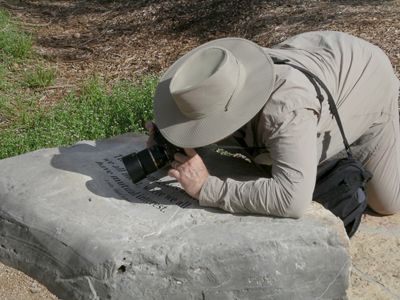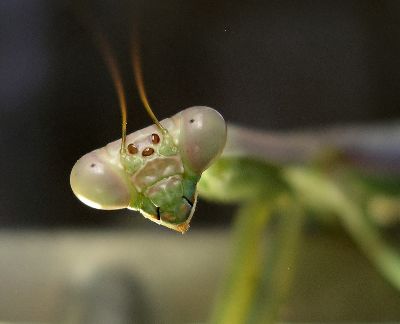
A fauna survey participant looking at wildlife
I retired from a music teaching career after 30 years, and once I had my days free I spent much more time outdoors, hiking and photographing. I didn't have to wait for the summer break, during which the temperatures here in central Texas soar, so I could enjoy the mild weather through the traditional school year. I had learned to make websites, which allowed me to publish essays and photos about things I observed while I leisurely explored the habitat around Austin. When working, I never imagined I would volunteer in any way, but I seemed to slip into doing so almost without noticing. I helped tend the plants in the Prehistoric Garden at Zilker, worked in the Fishes Collection at the University of Texas, and began presenting a slideshow once a year at the Austin Butterfly Forum. It seemed that learning more about topics that appealed to me was a fair tradeoff for donating my time and abilities.
Then, somewhere along the line, I started teaching again. Not in music this time, but about the natural world. It seemed that other people wanted to understand insects, plants, fungi, and ecology too. Not very many folks study arthropods in a broadly general way, so I found an empty niche. Hiking by myself was always engaging, but doing the same thing with others added another layer. More eyes see more things, and the group discussions created a very productive learning environment.
 A fauna survey participant looking at wildlife |
At the beginning of 2008, I found out about an activity I couldn't resist. On the first Saturday of every month, a lady named Melissa led a biodiversity survey at the Zilker Nature Preserve. While it was sponsored by Capital Area Master Naturalists, anyone could participate, so I signed up. My first experience was on Groundhog Day. The delight of being with folks that were keen to observe and understand their surroundings was enhanced by the fact that I could actually contribute what I had learned as well, helping to find and identify insects and other arthropods. I made new friends, and still participate to this day as a regular member of the survey teams.
One of the places that I had started visiting for my outdoor forays was the Lady Bird Johnson Wildflower Center. It is located only 10 minutes from our house, so it was a convenient destination when I had just a couple of hours free to take a walk. I became a member and visited so often that I got to know some of the garden staff and volunteers. I guess it was inevitable that they would eventually talk me into volunteering there too. Once I began helping with the Insectary, a little building where we raised caterpillars, I found that the questions people had about insects outstripped the resources available for answers. There was lots of information available about the plants, but not so much about the myriad tiny invertebrates that lived in the same habitat.
After thinking about it for quite awhile, weighing the time commitment vs. the attraction of the venture, I came up with a plan. Based on the success of the Master Naturalist Zilker surveys, I imagined doing something very similar at the Wildflower Center. The only thing that I found dissatisfying about the Zilker program was that it only occurred once a month. I could certainly understand why: given that Melissa lived well outside of Austin, it wasn't an easy trip. My proximity to the Wildflower Center, though, meant that I didn't have an issue with travel time. I decided that I could do weekly surveys.
I spent a couple of months during the winter of 2009 working out the details of what I decided to call The Fauna Project. I used my previous photos dating from 2006 to create a database of what species were seen when. Each week I could then just add the new information to this record. I also designed a website where I could post pictures after each survey, and I double- and triple-checked to see if I really felt comfortable allocating the amount of time I would devote to this activity. In February, 2010, I met with various staff members at the Wildflower Center and, with their encouragement, we began surveys on March 25, a Thursday morning. There were six people in that first team, and the number of participants has ranged from one (me) to ten.
During the first year, I presented a short summary of the Project at a staff meeting, the Wildflower Center published a web feature about the program, and the list of people receiving notifications about summary posts grew to well over 100. While the team members have varied, a few people have continued to participate as regulars. As one of many volunteer activities available at the Wildflower Center, The Fauna Project provides ongoing education as well as documentation of the many species found in the Gardens.
A typical survey begins well before the official 8:30 A.M. meeting time. Through much of the year, two or three of us are usually on site by 7:00 A.M., a time that is good for bird and mammal sightings. We also check the security lights around buildings for moths and other nocturnal insects. It can be a race to photograph as many subjects as possible before the wrens, phoebes and geckos eat them, and if the wind picks up, we can bid the insects goodbye. After the group gathers, we might head out on the trails, go straight into the gardens, or check areas around the plant nursery. There is no routine route for our surveys and we just wander as things attract our attention. Prime sites that we often inspect are the compost area, water features, and stone walls. Of course, we spend time at the plants that are currently in full bloom, and in a botanical garden such as this, there is enough diversity to assure there are abundant flowers at any given time.
 Wildlife looking back |
Here at the end of 2014, we have done 220 surveys in all sorts of weather, recorded around 2,000 different species of animals, and witnessed behaviors and relationships that are helping to create a more complete picture of how gardens work as ecosystems. By spending time over a long period, we have been privileged to witness such exceptional phenomena as baby birds fledging, rattlesnakes mating, insects laying eggs, and all manner of predators hunting their prey. The photographs we've taken have been added to other websites, including Moth Photographers Group and BugGuide, and some of our observations and information have been used by professionals in entomology publications. While identification of species is a major part of our work, we also document pollination, behaviors, predation, plant/animal relationships and survival strategies. As the Project continues, we add data that track the fluctuating populations of garden inhabitants, as well as record taxons we've not noted before. Our current cumulative species list includes 90 butterflies, 600 moths, 350 beetles, 120 spiders, 113 birds, 26 reptiles and 23 mollusks, just to name a few. We record everything from the most familiar animals, such as bees and millipedes, to the most obscure, like symphylans, barklice and owlflies. Besides general organization and record keeping, one of my responsibilities is to try and make our information as accurate as possible, so I am always trying to improve our identifications and correct the inevitable mistakes that occur. It is not unusual for a photo with a very general label (such as mosquito) to be narrowed down to genus or species months later, as new information comes to my attention.
The weekly surveys keep me pretty busy much of the year, but I do take a break starting before Christmas and lasting through January. When we resume in February, it is often during freezing weather, but spring arrives amazingly fast here in central Texas. Now that we've completed five years of The Fauna Project, I can conclude that it is indeed a worthwhile time and resource commitment. My best evidence for this is the fact that I am always excited as each Thursday morning survey approaches, and, despite rain, heat, or cold, we've never had a disappointing time yet!